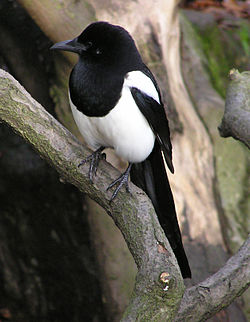Magpie
| Magpies | |
|---|---|

| |
| European Magpie | |
| Scientific classification | |
| Kingdom: | |
| Phylum: | |
| Class: | |
| Order: | |
| Family: | |
| Genera | |
Magpies (IPA: /ˈmæɡpaɪ/, SAMPA: /"m{g%paI/) are passerine birds of the crow family, Corvidae.
In Europe, "magpie" is often used by English speakers as a synonym for the European Magpie, as there are no other magpies in Europe outside Iberia. That bird was referred to as a "pie" until the late sixteenth century when the feminine name "mag" was added to the beginning.[1]
They are opportunistic scavengers and will eat anything once they have discovered it is edible. They are known to attack the nests of other birds and eat their fledglings.
The European Magpie is one of the few non-mammal species known to be able to recognize itself in a mirror test.[2]
Systematics and species
According to analysis,[3] magpies do not form the monophyletic group they are traditionally believed to be—-a long tail has certainly evolved (or shortened) independently in multiple lineages of corvid birds. Among the traditional magpies, there appear to be two evolutionary lineages: one consists of Holarctic species with black/white coloration and is probably closely related to crows and Eurasian jays. The other contains several species from South to East Asia with vivid coloration which is predominantly green or blue. The Azure-winged Magpie is a species with a most peculiar distribution and unclear relationships. It may be the single survivor of a long extinct group of corvid genera.[citation needed]
Other research[4] has cast doubt on the taxonomy of the Pica magpies, since it appears that P. hudsonia and P. nuttalli may not be different species, whereas the Korean race of P. pica is genetically very distinct from the other Eurasian (as well as the North American) forms. Either the North American, Korean, and remaining Eurasian forms are accepted as three or four separate species, or there exists only a single species, Pica pica.
Holarctic (black-and-white) magpies
- Genus Pica
- European Magpie, Pica pica
- Black-billed Magpie, Pica hudsonia (may be conspecific with P. pica)
- Yellow-billed Magpie, Pica nuttalli (may be conspecific with P. pica/P. hudsonia)
- Korean Magpie, Pica sericea (may be conspecific with P. pica)
Oriental (blue/green) magpies
- Genus Urocissa
- Formosan Blue Magpie Urocissa caerulea
- Red-billed Blue Magpie, Urocissa erythrorhyncha
- Gold-billed Magpie, Urocissa flavirostris
- White-winged Magpie, Urocissa whiteheadi
- Sri Lanka Blue Magpie, Urocissa ornata
- Genus Cissa
- Green Magpie, Cissa chinensis
- Yellow-breasted Magpie, Cissa hypoleuca
- Short-tailed Magpie, Cissa thalassina
Azure-winged Magpie
- Genus Cyanopica
- Azure-winged Magpie, Cyanopica cyana
Other "magpies"
- The Black Magpie, Platysmurus leucopterus, despite its name, is neither a magpie nor, as was long believed, a jay, but a treepie. Treepies are a distinct group of corvids externally similar to magpies.
- The Australian Magpie, Cracticus tibicen, is conspicuously piebald, with black and white plumage reminiscent of a European Magpie. It is a member of the family Artamidae, and not a corvid.
Magpie poem
There is superstition related to magpies saying that seeing one is bad luck. Saluting to the magpie apparently counteracts this. There is also a poem related to this superstition indicating what it means to see a certain number of magpies together:
One for sorrow Two for Joy Three for a girl Four for a boy Five for silver Six for gold Seven for a secret never told
References
- ^ Funk & Wagnalls Wildlife Encyclopedia, Volume 11, 1974, p. 1339.
- ^ Prior H.; et al. (2008). "Mirror-Induced Behavior in the Magpie (Pica pica): Evidence of Self-Recognition" (PDF). PLoS Biology. 6. Public Library of Science: e202. doi:10.1371/journal.pbio.0060202. Retrieved 2008-08-21.
{{cite journal}}: Explicit use of et al. in:|author=(help)CS1 maint: unflagged free DOI (link) - ^ Ericson et al. (2005)
- ^ Lee et al., 2003
- Anonymous (2006): The Word Origin Calendar: Sat./Sun. March, 11-12, 2006. Accord Publishing.
- Ericson, Per G. P.; Jansén, Anna-Lee; Johansson, Ulf S. & Ekman, Jan (2005): Inter-generic relationships of the crows, jays, magpies and allied groups (Aves: Corvidae) based on nucleotide sequence data. Journal of Avian Biology 36: 222-234. PDF fulltext
- Lee, Sang-im; Parr, Cynthia S.; Hwang, Youna; Mindell, David P. & Choe, Jae C. (2003): Phylogeny of magpies (genus Pica) inferred from mtDNA data. Molecular Phylogenetics and Evolution 29: 250-257. PDF fulltext
- Tickner, Lisa (1980-04-01). "One for sorrow, two for mirth". Oxford Art Journal. Retrieved 2007-03-02.
External links
- Magpie videos, photos and sounds on the Internet Bird Collection
